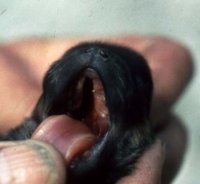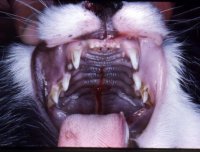 Back
Back
|
CLEFT PALATE
Note for Pet Owners: You should seek the advice of
your veterinarian if your pet is ill as only he or she can correctly advise
on the diagnosis and recommend the treatment that is most appropriate for
your pet. Because there may be an hereditary basis for this condition affected animals should not be used for breeding Feedback Request Provet is conducting an investigation into the possible link between excessive dietary vitamin A intake and the occurrence of congenital cleft palate. If you see a case please submit the case history with full details of the food given and any nutritional supplements administered to feedback@provet.co.uk . If we get sufficient cases submitted we shall publish the results on this website. Topics on this Page: |
Description
Cleft palate is commonly seen by veterinarians in dogs, cats and other species.
Unfortunately many neonates with this disorder die early or are destroyed by the
breeder so accurate statistics on the true incidence of the disease are not
available.
Defects (clefts) in the hard palate that forms the roof of the mouth, or the soft palate which lies caudally and separates the oropharynx from the nasopharynx may be congenital or acquired.
The cleft can involve the soft palate alone, the hard palate alone or both. The defect can be bilateral (ie involve tissues lying both sides of the midline) or unilateral. The latter are usually seen in the soft palate.A newborn puppy with severe cleft palate
Congenital cleft palate is an abnormality which is thought to occur during fusion of the maxillary process with the medial nasal process, when the mesodermal fusion develops across the fused epithelial surfaces. If the epithelial barrier does not degenerate or if the mesodermal connective tissue is deficient cleft palate results.
Acquired clefts are due to trauma - usually road traffic accidents or falls from a height.
A cat with acquired cleft hard palate and soft palate following trauma
Cause
There are several possible causes for congenital cleft palate:
a) Genetic cause
An hereditary basis for the disease is suspected for congenital clefts but the mechanism has not yet been determined. Any such genetic trait is thought to be multifactorial recessive, polygenic and dominant with partial penetration.
b) Excess vitamin A intake during pregnancy
In 1967 Wiersig and Swenson reported that 125,000 IU of Vitamin A per kilogram body weight given to Beagle bitches on days 17-22 of gestation resulted in cleft palate developing in their puppies.
Vitamin A is an essential nutrient for normal growth and defects in bone growth are seen with insufficient as well as excessive dietary intake. Vitamin A has a controlling influence over both the osteoblasts and osteoclasts in epithelial cartilage and so there is a rational explanation as to why excessive vitamin A intake might result in cleft palate.
In addition, commercially prepared complete pet foods contain more than sufficient available vitamin A yet breeders and owners frequently supplement their pet's ration with vitamin supplements. High vitamin A content is also a feature of many natural food sources including liver and fish oils. Cod liver oil is a very popular nutritional supplement with pet owners and it contains 18000mg per 100ml (4000 IU per gram). Some vitamin injections contain as much as 500,000 IU of vitamin A per ml.
c) Cortisone
Administration of cortisone during pregnancy can lead to the development of cleft palate in the fetus
d) Hydroxyurea
Administration of the cytotoxic drug hydroxyurea (hydroxycarbamide) is reported to cause cleft palate.
Acquired cleft palate is common following falls from a height, and less commonly following road traffic accidents.
Breed Occurrence
The following breeds of dog have been reported to have cleft palates : mixed and
small terrier breeds, Beagle, Bernese Mountain Dog, Boston Terrier,
Bullmastiff, Bull Terrier, Chihuahua, Cocker Spaniel, Collie, Dachshund, English
Bulldog, German Shepherd Dog, Golden Retriever, Miniature Schnauzer, Norwegian
Elkhound, Pekingese, Shih Tzu, Staffordshire Bull Terrier, Toy Poodle
Wire-haired Fox Terrier,
Brachycephalic breeds are reported to have about 30% risk, whereas German Shepherd Dogs have the lowest risk.
In cats cleft palates have been reported in mixed breeds, Siamese, Manx and Abyssinians - with Abyssinians having the highest risk.
Signs
There is a visible split in the roof of the mouth or the soft palate. This
results in food material (particularly fluids) passing into the nasal cavity and
the following signs :
- Fluids eg milk pass down the nose during feeding
- Sneezing
- Coughing/gagging
- Snuffling
- Rhinitis
- Pneumonia (due aspiration of foods)
- Poor weight gain
- Stunted growth
- Inability to feed properly
Bronchopneumonia accounts for 30% of deaths due to cleft palate.
Cleft palate is sometimes associated with congenital deformities in other body systems.
Complications
Diagnosis
Diagnosis is based on the clinical signs and careful visual examination of the
oral cavity. Fine-line fissures sometimes occur in the hard palate in the
midline of the roof of the mouth following trauma such as road traffic accidents
or falls from a height. These can be difficult to detect unless a careful
examination is made.
Consider excess dietary vitamin A intake as a possible cause for
congenital cleft palate when it occurs and review the mothers nutritional history.
Treatment
Prevention
For the prevention of congenital cleft palate Provet makes the following recommendations :
- Excessive dietary vitamin A intake must be avoided during pregnancy, so
- Avoid unregulated multivitamin or vitamin A supplementation during pregnancy
- Avoid unregulated liver intake during pregnancy
- Avoid unregulated fish oil supplementation during pregnancy
- Great care is needed when administering parenteral vitamin supplements to pregnant animals
- Feed a complete pet food formulated for pregnancy without supplements
Treatment
Surgical repair of acquired lesions, and closure of congenital defects is recommended. In all cases surgery should be performed as soon as possible before secondary complications occur.
Most techniques involve the use of a flap taken by undermining the tissue on one or both sides of the defect and suturing them together. Techniques using artificial prostheses to close large defects have also been described in the literature, but these are not readily available and rejection is a common problem.
- Freshen the edges of all tissues being sutured together
- Avoid post-operative oral feeding/fluid
- Feed for 5-6 days using a nasogastric tube or (BETTER) a gastrostomy tube. The latter can easily be positioned at the time of surgery.
Prognosis
Good for minor defects. Guarded to poor for severe defects. Poor once secondary
complication of inhalation pneumonia has developed.
Long term problems
Updated January 2016
d>

